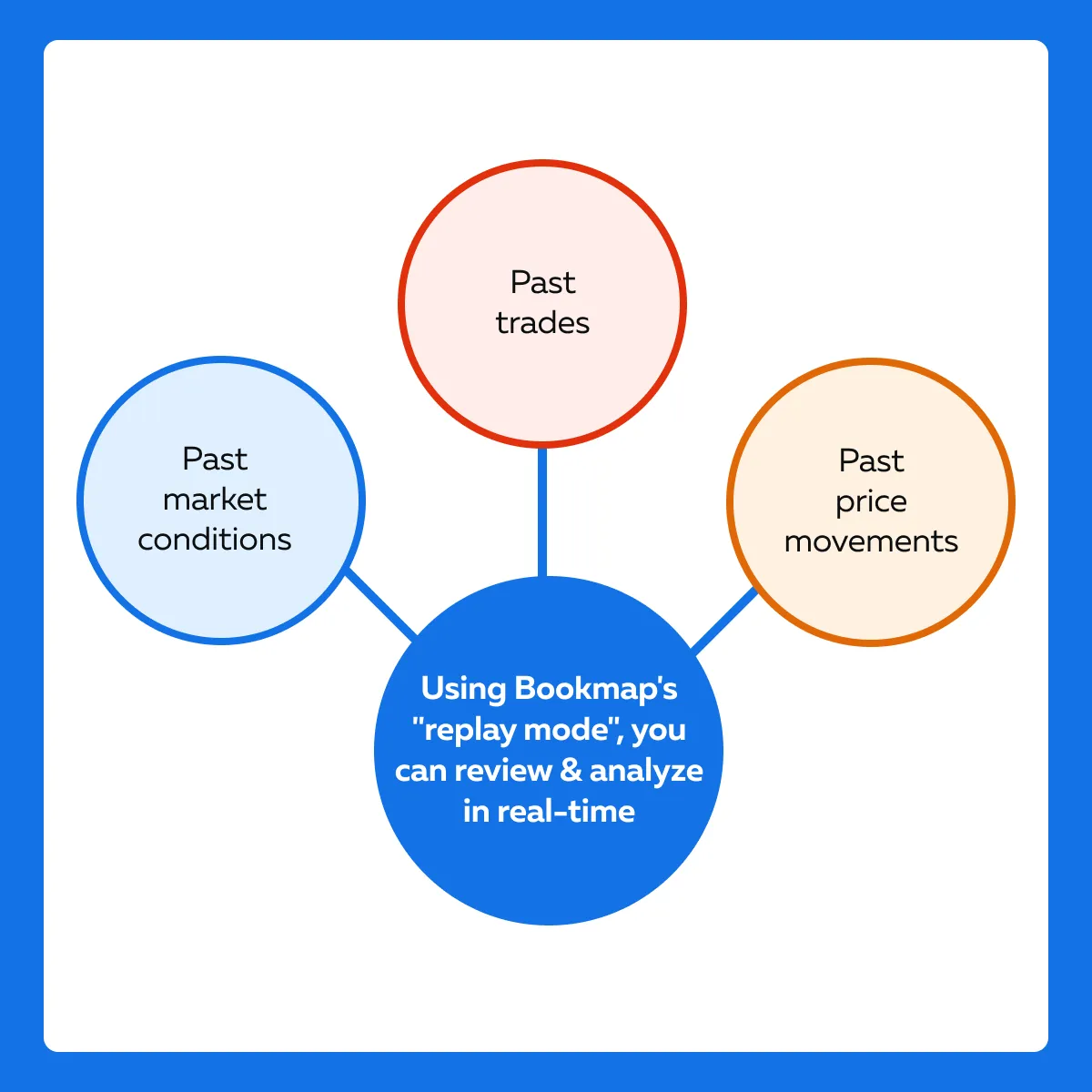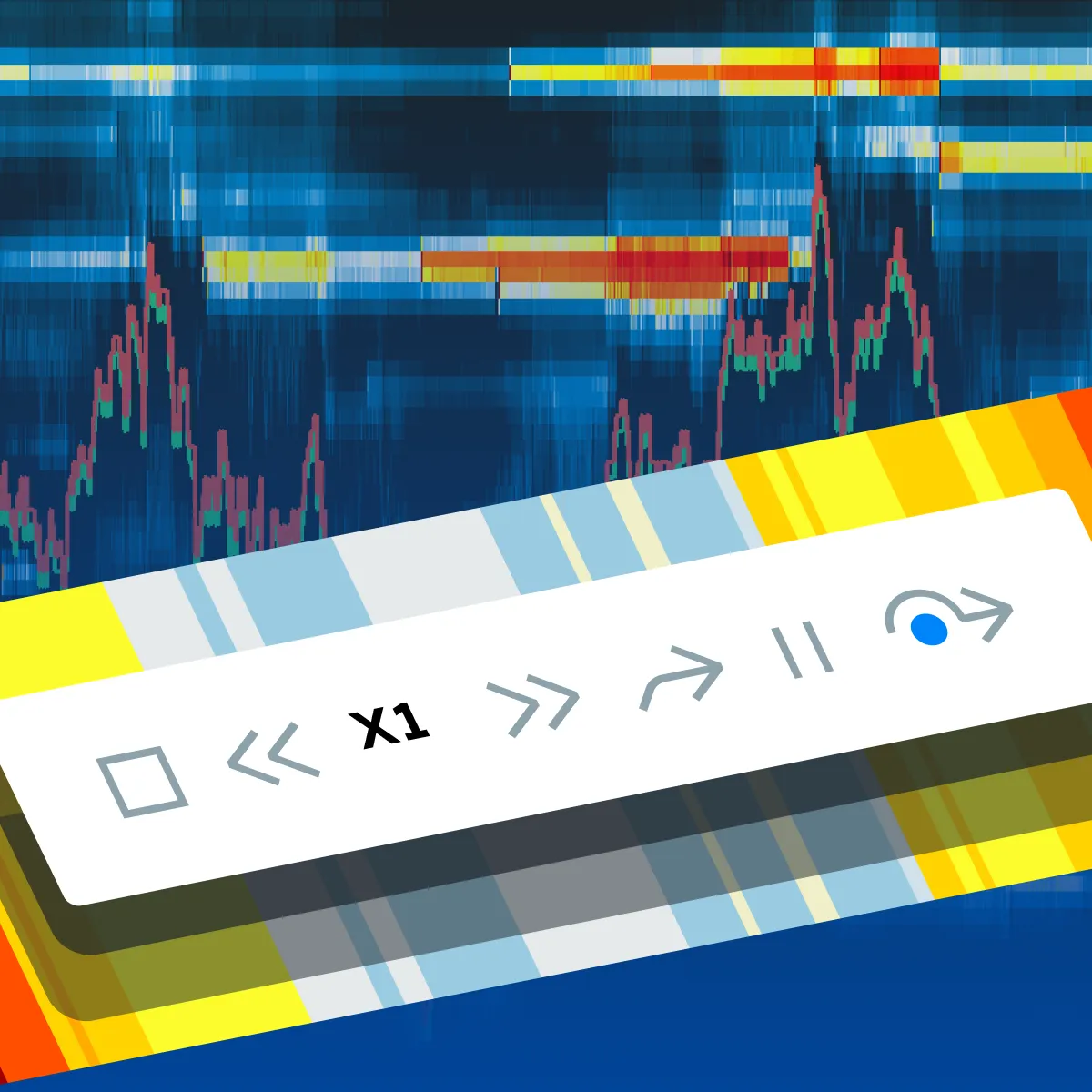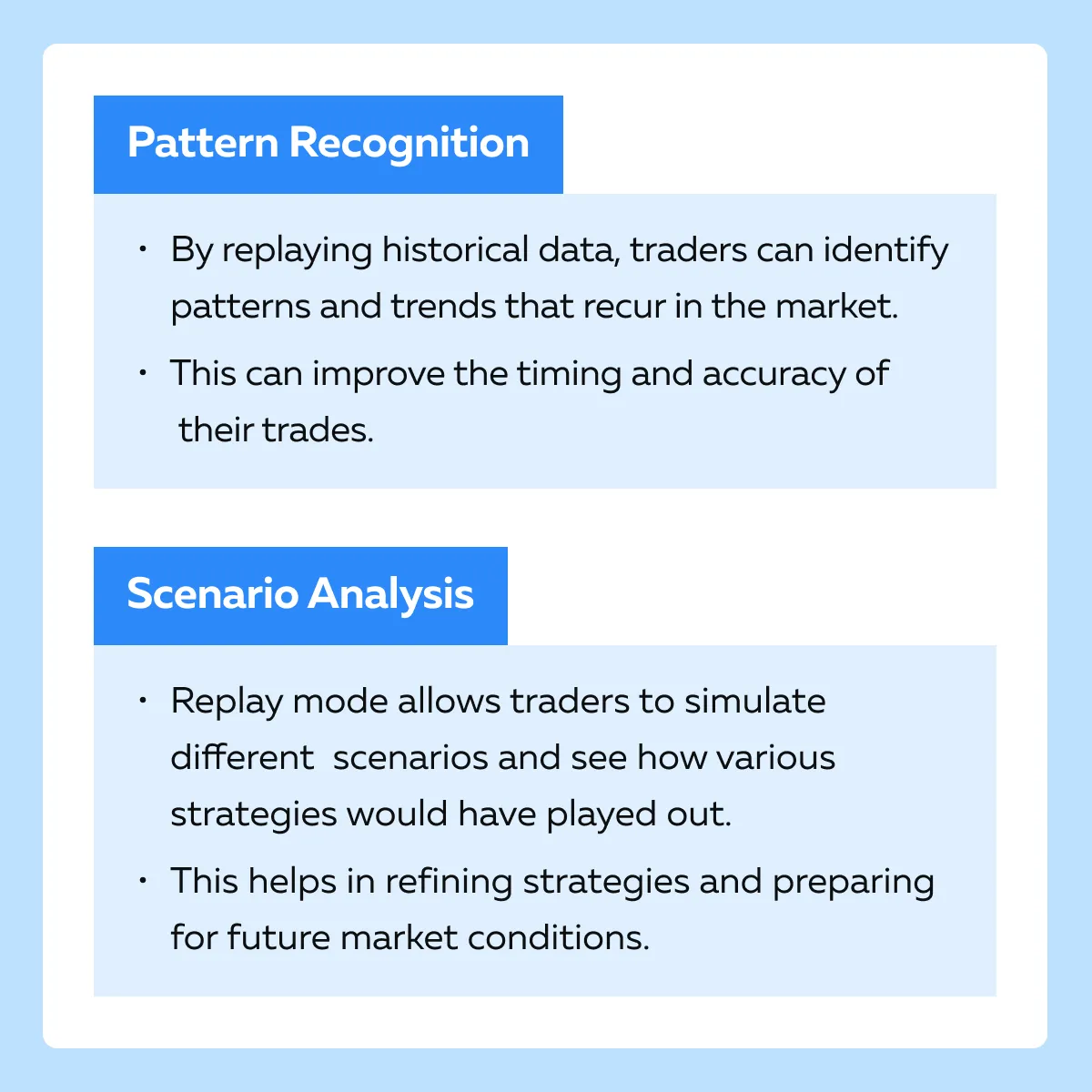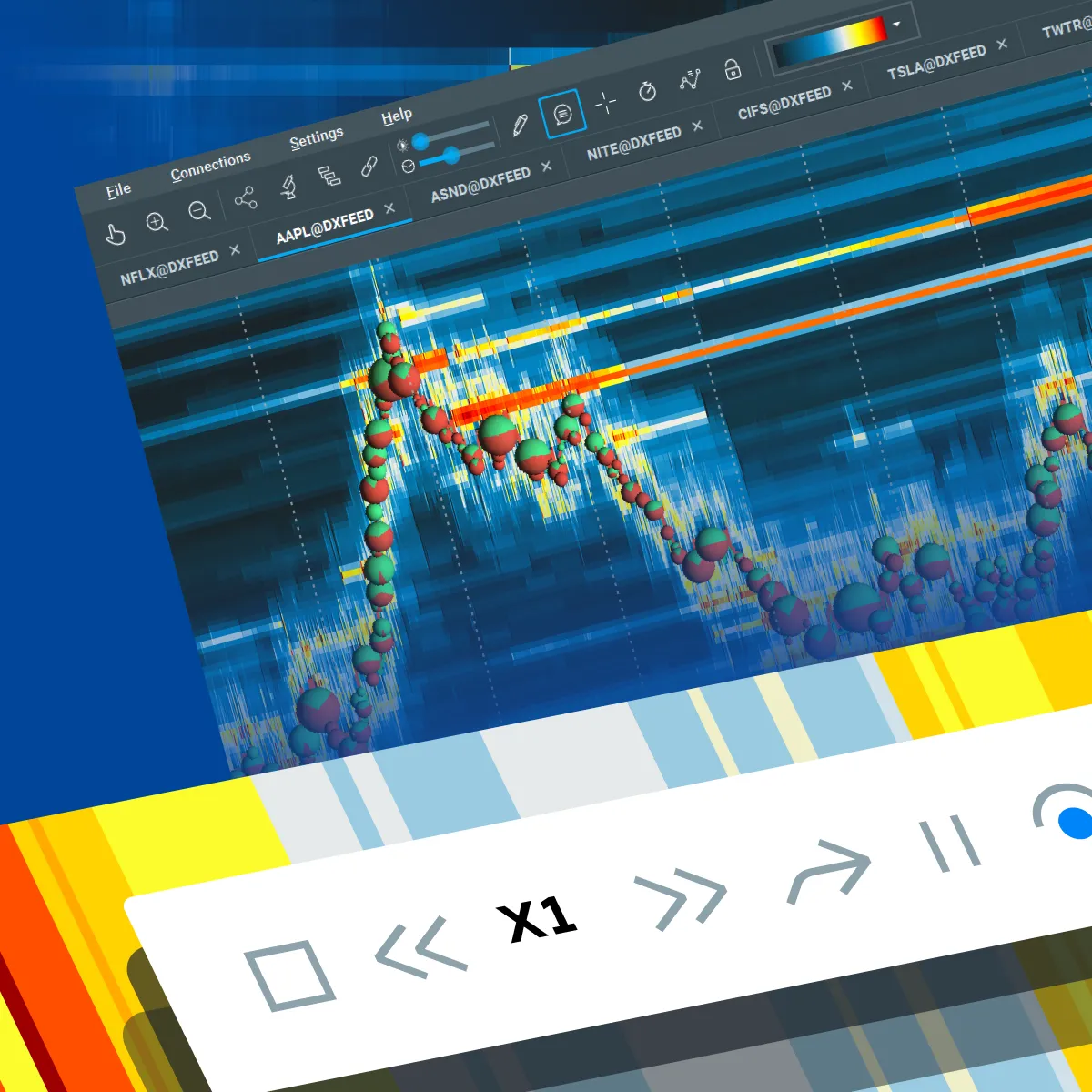

December Trading
Deals Are Live!
Save on Global+, data access,
and add-ons.
See All December Deals

Black Friday
Nov 28-Dec 31
0 days : 17 hours
50% OFF Global+ Quarterly
+ 50% OFF Data (3 months)

Cyber Monday
Dec 1 - Dec 31
0 days : 17 hours
60% OFF Global+ Monthly
+ Data (1 month)

Add-on Deals
Dec 1 - Dec 31
0 days : 17 hours
50% OFF
Add-ons

New Year Sale
Dec 26 - Jan 1
1 days : 17 hours
30% OFF Global+ Lifetime
*Data not included
Education
July 19, 2024
SHARE
Pro Tips Using Bookmap’s Replay Mode: Expert Webinar Insights
Author and theologian L. Thomas Holdcroft once wrote, “The past is a guidepost, not a hitching post.” Holdcroft’s wisdom applies not only to the real world but also to the world of trading. Numerous studies have shown that traders who effectively analyze past market data and learn from their mistakes are often the ones executing the most profitable trades. In this article, we’ll explore how to use the advanced market analysis tool Bookmap’s Replay Mode—a modern feature that lets you review past market data as if it were happening live—to improve your trading skills. You will learn how to analyze your past trades, identify what went well, and understand where mistakes were made. By doing this, you can refine your strategies and make better trading decisions.
We’ll also cover advanced techniques for dissecting complex trading scenarios. This includes analyzing order flow and market liquidity to gain deeper insights into market behavior. Additionally, you’ll learn how to use Replay Mode to backtest trading strategies such as scalping and swing trading. Let’s begin.
What is Replay Mode & Why is it Useful?
The “Replay Mode” is a popular feature within Bookmap. It allows traders to “replay historical market data.” It is incredibly beneficial for both novice and experienced traders. See the graphic below for better understanding:

Let’s understand the Replay Mode in detail:
- Replay Mode provides traders with the ability to:
- Rewind the markets
and
- Replay historical trading sessions as if they were happening live.
- While replaying, traders get to witness all aspects of market activity, such as:
- Price movements,
- Order flow, and
- Liquidity.
- Also, traders can pause, rewind, and fast-forward through market data to closely examine specific events and trading behaviors.
What are the Advantages of Using Replay Mode?
Replay Mode allows traders to go back and review their past trades in detail. By analyzing these trades, traders can identify:
- What did they do well?
- Where did they make mistakes?
- How can they learn from these past mistakes?
This self-reflection is crucial. It helps in continuous improvement and in refining one’s trading strategies. Furthermore, Replay Mode helps in:
- Analyzing Order Flow and Market Liquidity
-
-
- Replay Mode enables traders to see how orders were placed and executed in the market.
- This information provides insights into market depth and liquidity dynamics that are not always apparent in real-time trading.
-
- Improving Decision-Making Skills Based on Historical Data
-
- By studying historical market data, traders can enhance their decision-making skills.
- Replay Mode offers a unique opportunity to practice and perfect trading strategies without the pressure of live trading.
- This practice often leads to better performance in live markets.
Now, let’s understand the practical application of Replay Mode using a hypothetical example.
Example of Using Replay Mode
Say a trader wants to revisit a specific trading day. They wish to better understand market dynamics and refine their strategies. Being a Bookmap user, they can easily do so by using Bookmap’s Replay Mode. Let’s check out the steps:
- Revisiting a Trading Day
- The trader selects a past trading session where they experienced either significant success or difficulty.
- Using Replay Mode, they replay the entire session from start to finish.
- Understanding Market Dynamics
- As the trader replays the session, they closely observe how the market responded to various economic events such as:
- News releases,
- Changes in order flow, and
- Other noteworthy events.
- This helps in understanding the underlying market dynamics that influence price movements.
- As the trader replays the session, they closely observe how the market responded to various economic events such as:
- Identifying Key Entry and Exit Points
- By analyzing the replayed session, the trader pinpoints the exact moments when they entered and exited trades.
- After this, they evaluate whether these decisions were optimal, based on the information available at that time.
- Adjusting Strategies
- Now, with a clear understanding of what worked and what didn’t, the trader can modify their trading plan.
- For example,
- Say they notice that they consistently exited trades too early.
- So, they might adjust their exit strategy to capture more profit in future trades.
How to Debrief Your Trading in Bookmap’s Replay Mode
In an exclusive webinar organized by Carmine Rosato, Rosato covers the debriefing process using Bookmap’s Replay Mode. He tells traders how they can review and analyze their trades using this modern feature. Let’s understand Carmine Rosato’s approach in detail and cover some major insights from the webinar.
How to Review Past Trades to Identify Strengths and Weaknesses
Replay Mode allows traders to go back and thoroughly review their trades. Also, Carmine emphasizes the importance of understanding both the strengths and weaknesses of each trade. By replaying the trading session, traders can see exactly:
- What they did right
and
- Where they could have improved.
To do this effectively, Rosato advocates to:
- Identify Successful Trades
- Look at the profitable trades.
- Understand the conditions and decisions that led to these successes.
- Analyze Unsuccessful Trades
- Focus on trades that did not go as planned.
- Identify the mistakes or missed opportunities and learn from them.
How to Analyze Order Flow and Market Liquidity with Replay Mode?

While doing past analysis using the Replay Mode of Bookmap, it is crucial to analyze:
- Order flow
and
- Market liquidity.
Let’s see why:
| Order Flow Analysis | Market Liquidity |
and
|
|
Since both are critical components of trading, they can be closely analyzed using Replay Mode. In the webinar, Rosato has clearly demonstrated how to interpret these elements to make better trading decisions. Let’s check out some practical steps to analyze order flow:
- Setup Replay Mode
-
-
- Begin by selecting a specific trading session you want to analyze.
- Load the historical market data into Bookmap’s Replay Mode.
-
- Focus on Key Timeframes
-
-
- Identify and focus on key timeframes during the trading session.
- These could be times of
- High volatility,
- Significant price movements, or
- Periods when you executed trades.
-
- Examine Order Book Activity
-
-
- Pay attention to the order book activity.
- Look for large orders, changes in order size, and how these orders impact price movements.
- For example:
- At 19:52, the webinar mentions to trade without looking at the order flow.
- Rosato shows how ignoring order flow impacted trade decisions.
-
- Identify Patterns in Order Flow
-
-
- Look for recurring patterns in the order flow.
- These could be large buy or sell orders that consistently lead to price changes.
- For example,
- At 22:55, the webinar mentions that understanding order flow at certain times is important.
- Use this to identify patterns during critical times.
-
- Analyze Trade Executions
-
-
- Replay the moments when trades were executed.
- Observe how the order flow influenced these executions and whether the trades aligned with the market sentiment.
-
- Assess Market Impact
-
- Evaluate how large orders or clusters of orders affected:
- Market liquidity
- Evaluate how large orders or clusters of orders affected:
and
- Price movements.
- This helps in understanding the market impact of significant trades.
Now, having understood how to analyze order flow, let’s explore some practical steps to analyze market liquidity:
- Identify Liquidity Zones
-
-
- Replay the session and identify zones of high and low liquidity.
- High liquidity zones usually have a large number of buy and sell orders while low liquidity zones have fewer orders.
- For example:
- Rosato clearly states at 59:24, in the webinar, to look at how order flow and market liquidity are represented to understand where liquidity was high or low.
-
- Monitor Price Reactions
-
-
- Observe how prices react when they enter high or low liquidity zones.
- High liquidity provides strong support or resistance, while low liquidity leads to rapid price movements.
-
- Evaluate Trade Volume
-
-
- Pay attention to the volume of trades in different liquidity zones.
- Higher trade volume in high liquidity zones indicates strong market interest and stability.
-
- Analyze Spread Changes
-
-
- Watch for changes in the bid-ask spread.
- A widening spread indicates decreasing liquidity, while a narrowing spread suggests increasing liquidity.
-
- Consider the Time
-
-
- Liquidity often varies with the time of the day.
- Replay sessions from various times to understand how liquidity changes throughout the trading day.
-
- Impact of News Events
-
- Use Replay Mode to observe how major news events impact market liquidity.
- Notice the immediate and longer-term effects on the order book and price movements.
Techniques for Improving Decision-Making Based on Historical Data
Using historical data to improve decision-making is a key benefit of Replay Mode. Rosato illustrates several techniques to leverage this data effectively. See the graphic below:

Step-by-Step Debrief of a Trading Session
During the webinar, Carmine Rosato also provides a detailed, step-by-step debrief of a trading session. He clearly highlights how to spot and learn from mistakes. Let’s understand his process in simple steps:
- Initial Review
- Start by replaying the entire trading session without making any notes.
- This gives a general overview of the day’s trading activities.
- Detailed Analysis
- Go through each trade one by one.
- For every trade, make a note of:
- The entry and exit price points,
- The reasoning applied to the trade, and
- The final result.
- Identify Mistakes
- Look for any mistakes made during the trades.
- These could be:
- Entering the market too early,
- Exiting too late, and
- Misinterpreting market signals.
- Learning Points
- For each mistake identified, note down what could have been done differently.
- This is crucial for learning and avoiding similar mistakes in the future.
- Strategy Adjustment
- Based on the review, make necessary adjustments to the trading strategy.
- This could involve:
- Tweaking entry and exit points,
- Changing the criteria for entering a trade, and
- Improving risk management techniques
How to Improve Your Trading Using Bookmap’s Replay Mode
In another exclusive webinar, Academy member ‘Robbed’ shares valuable insights on how to enhance trading skills using Bookmap’s Replay Mode. Let’s see how you can make the most of this feature:
How to Set Up Replay Mode for Different Market Scenarios?
To start, you need to set up Replay Mode correctly. This involves selecting various market scenarios you want to review and practice. For example, you might choose to look at:
- High volatility periods,
- Low liquidity moments, or
- Specific events like news releases.
By doing so, you can get a comprehensive understanding of how the market behaves under different conditions.
How to Integrate Replay Mode into Trading Routines?

It is essential to note that integrating “Replay Mode” into your daily routine can significantly boost your trading skills. Robbed also emphasizes using the Replay Mode daily after the market closes. This practice helps in:
- Reviewing trades
and
- Identifying what worked and what didn’t.
Making it a habit ensures continuous learning and improvement. Here’s a simple routine you can follow:
- Post-Market Review
- Spend some time each day reviewing your trades using Replay Mode.
- Set Clear Goals
- Focus on what you want to achieve during these sessions.
- Whether it’s refining your entry and exit points, understanding order flow, or spotting mistakes, ensure the due diligence is done.
- Document Learnings
- Keep a trading journal where you note down key observations and improvements.
How Can Replay Mode Reveal Hidden Market Patterns?
One of the key advantages of using Replay Mode is its ability to uncover hidden market patterns that you might miss in real-time trading. For example, you might discover a hidden support level that wasn’t apparent during live trading. Let’s understand better through a hypothetical example showing how to identify hidden support levels:
- Say you’re trading, and you miss noticing a support level because of the fast-paced market movement.
- By replaying the market movement, you can slow down the action this time around.
- You can see where the buyers consistently stepped in and created a support level.
- This insight is invaluable and can be applied in future trades to improve your entry points and risk management.
For an in-depth exploration of the topic, access the full webinar.
Bookmap Trading Tips & Tricks
In an insightful webinar, Bruce Pringle and Scott Pulcini shared valuable tips and tricks for gaining an edge using Bookmap’s charts and DOM (Depth of Market). Let’s have a look at some major trading tips and tricks discussed in the session:
Advanced Techniques for Dissecting Complex Trading Scenarios
- Order Flow and Liquidity
-
-
- Utilizing the Bookmap chart helps traders see the flow of orders and liquidity.
- This provides a clearer picture of market dynamics.
-
- Trade Management
-
- By moving orders directly on the chart, traders can:
- Manage their trades more efficiently
- By moving orders directly on the chart, traders can:
and
- Align their actions with the market’s order flow.
- Live Market Analysis
-
- The traders must refer to the detailed breakdown of live trades and enter and exit positions based on liquidity observations.
How to Use Replay Mode to Backtest Trading Strategies?
As discussed earlier, the Replay Mode allows traders to review and analyze past trades. It helps in understanding what went right or wrong in a trade. This feature is particularly useful for learning and improving trading strategies by replaying past market conditions. Let’s see in simple steps how you can use Replay Mode to backtest your trading strategies:
- Step 1: Select a Date and Time
- Choose a specific date and time from the past that you want to review.
- This should be a period where you make trades or want to study market behavior.
- Step 2: Play the Market Activity
-
-
- Start the replay to watch the market activity unfold.
- You can speed up or slow down the playback to focus on key moments.
-
- Step 3: Analyze Your Trades
-
-
- Watch how you entered and exited trades.
- Look for patterns or mistakes.
- Ask yourself questions like, “Did I enter too early? Was my stop-loss set correctly?”
-
- Step 4: Test New Strategies
-
-
- Try out different trading strategies in Replay Mode.
- For example,
- If you’re testing a scalping strategy, see how small price changes affect your trades.
- For swing trading, look at longer-term trends.
-
- Step 5: Refine Your Approach
-
- Based on what you observe, adjust your strategy.
- If you notice certain patterns that consistently lead to losses, you can avoid those in the future.
For example, you followed these steps to backtest a scalping strategy:
- Step 1: Select a busy trading day from last month.
- Step 2: Replay the market from that day and watch for small, quick price movements.
- Step 3: Practice entering and exiting trades rapidly, focusing on capturing small profits.
- Step 4: Note down what worked well and what didn’t.
- Step 5: Adjust your strategy based on these observations and try again.
It must be noted that by practicing using Replay Mode to test and refine your strategies, you can improve your trading skills and make more informed decisions in live markets.
How to Use Historical Data to Develop Predictive Models?
By studying historical data, traders can develop models to predict future market movements. This involves identifying patterns and trends by observing:
- Past price movements,
- Order flow, and
- Liquidity.
For example, when you are following the strategy of “scalping”:
- Replay historical data to practice quick, short-term trades.
- Observe how small price movements and liquidity affect trade outcomes and refine your approach accordingly.
Similarly, for “swing trading”
- Use Replay Mode to analyze longer-term trades.
- Look at how larger price trends develop over time.
- Adjust your strategy to capture these moves effectively.
By using these advanced techniques, Replay Mode, and historical data, traders can refine their strategies and improve their chances of success in the market. For an in-depth exploration of the topic, access the full webinar.
Practical Applications of Replay Mode

Replay Mode significantly enhances the trading outcomes through thorough analysis and practice. Let’s check out some practical applications and real-world examples demonstrating how traders have leveraged “Replay Mode” to achieve better results.
Example 1: Analyzing a Volatile Market Session
A trader used Replay Mode to revisit a particularly volatile market session. In real-time, the rapid price movements made it challenging to make informed decisions. By replaying the session, the trader could slow down the action and closely examine each significant market move. This way, they were able to:
| Identify Missed Opportunities | Recognize Pattern |
|
|
Example 2: Refining Risk Management Strategies
Another trader focused on improving their risk management strategy using Replay Mode. They replayed sessions where they experienced significant losses due to sudden market shifts. By analyzing these sessions, the trader could see exactly how sudden market movements affected their positions. This clarity helped in understanding the weaknesses in their existing risk management approach. Furthermore, it also helps in:
| Adjusting Stop-Loss Levels | Scenario Planning |
|
|
How to Integrate Replay Mode into Your Regular Trading Routine?
To fully benefit from Replay Mode, it’s essential to integrate it into your regular trading routine. Here’s how you can do that effectively:
- Set Aside Dedicated Time
- Allocate specific times in your schedule for reviewing past trades using Replay Mode.
- This dedicated review period helps ensure you consistently analyze your trades and learn from them.
- Identify Patterns
- Use Replay Mode to identify recurring patterns in the market.
- Recognizing these patterns can provide a significant edge in predicting future market movements.
- Practice New Strategies
- Replay Mode offers a risk-free environment to practice new trading strategies.
- Before implementing a new strategy in the live market, test it thoroughly using historical data.
- This practice helps refine the strategy and boosts your confidence in its effectiveness.
- Continuous Improvement:
- Make Replay Mode a part of your continuous improvement process.
- Regularly reviewing and analyzing your trades helps you:
- Stay sharp,
- Adapt to changing market conditions, and
- Continuously refine your trading approach.
Conclusion
Bookmap’s Replay Mode is a powerful tool for traders to improve their skills and strategies. By allowing you to replay historical market data, it helps you analyze past trades and market conditions in detail. You can see the price movements, order flow, and liquidity and analyze what went right or wrong in your trades. This helps in refining your trading strategies and making better decisions while trading.
Replay Mode is especially useful for backtesting new strategies without the pressure of risking capital. You can test different approaches, like scalping or swing trading, and adjust your strategy based on your observations. It also helps improve risk management by allowing you to see how market shifts affect your positions, teaching you how to adjust stop-loss levels accordingly.
By regularly using Replay Mode, you can identify patterns, understand market dynamics, and continuously improve your trading skills. It’s a valuable addition to any trader’s routine and ensures you are better prepared to execute trading decisions. Gain more in-depth trading insights with Bookmap’s trading tips and tricks playlist.
